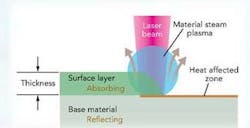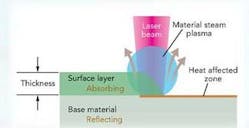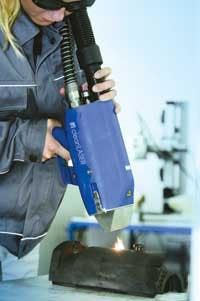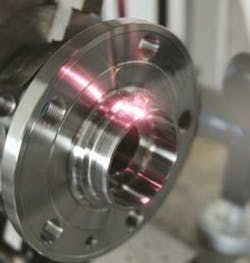Laser surface treatment is an attractive option to traditional labor-intensive cleaning methods
by Georg Heidelmann
Advanced industrial lasers have evolved well beyond simple cutting and welding applications. Laser technology now offers an industrial de-coating and surface cleaning solution that is cost effective as well as responsive to environmental concerns. From the automated cleaning of molds to precise de-coating to oxide removal, laser surface treatments are proving to be an attractive option to traditional labor-intensive methods.
In the past decade laser paint removal and cleaning systems have generated significant interest as a viable alternative to conventional cleaning and paint removal technologies. Research on mobile, reliable, and powerful laser systems for cleaning and paint removal operations began in the late 1980s with the modification of welding or cutting lasers into laser systems for surface preparation. This approach did not meet the requirements for surface preparation, which are significantly different than for cutting and welding.
In the early 1990s, research took place around the world for more efficient, reliable laser systems for surface preparation work. It took another few years to develop the technology from experimental laboratory systems to dependable systems capable of use in day-to-day industrial operations. Today, a wide variety of industries have adopted laser systems for a range of surface preparation tasks. Applications include mold cleaning, paint removal, joining pretreatment, oil and grease removal, and many more.
Operating principle
The laser generates a directed and monochromatic beam of light which typically is tightly focused to create high power density. At the focal point, the energy of the intense laser beam will be absorbed by the contamination or paint layer, thermally incinerating or sublimating the target material, such as paint or contamination (see FIGURE 1). These processes will, in combination with the resulting micro-thermal shockwave, remove the target material as long as the target material is able to absorb the incident laser energy. The better the target material absorbs the energy, the faster it can be removed.
Color, chemical composition, and thickness of the target layer all have a direct impact on the effectiveness of the process. The removal process automatically stops once a metal, or otherwise relatively reflective, substrate is reached. Reflective surfaces do not generally readily absorb the laser energy.
Any residual heat transfer into the substrate material can be a critical factor. To minimize this effect, many laser equipment manufacturers use pulsed laser sources. The beam intensity (laser power per beam spot) is a critical parameter for the heat transfer into the substrate material. Very short laser pulses with a pulse duration of only a few nanoseconds (ns) in combination with a very small focus diameter (0.02 in) or longer pulses in the millisecond (ms) range with a larger focus diameter (0.2 in) result in a minimal heat transfer into the substrate material. Under normal operating conditions and with the right process parameters, damage to the substrate material can be avoided.
The heat transfer factor of continuous-wave laser systems is much higher and might result in substrate temperatures that will damage the substrate. Test results with a handheld pulsed Nd:YAG laser with an average laser power of 500W (peak power of more than 400kW) on an aircraft aluminum sheet resulted in maximum substrate temperatures of 170 °F.
Pulsed laser systems generate laser power levels well beyond the average power of the laser source. A pulsed 150W solid-state laser will generate a peak pulse power of more than 160kW. This high peak power and the above mentioned beam parameter result in a power intensity removing many target materials with acceptable production rates.
Currently, there are three different kinds of laser sources available for surface preparation works. The main difference is the laser beam generation and the resulting beam delivery configuration.
Solid-state Nd:YAG laser–The operating wavelength of 1064nm lies within the transmission bandwidth of common optical glass and enables the use of fiber-optic cables for beam delivery, dramatically improving the flexibility of the laser systems (see FIGURE 2). Nd:YAG lasers can be used for work on hard-to-reach areas. Currently, the maximum fiber optic length is 150ft. Nd:YAG lasers are nearly maintenance free and simple to operate. Pulsed systems for surface preparation use reach average laser power levels of up to 1000W.
TEA CO2 laser–The transversely excited atmospheric (TEA) CO2 laser uses a specific gas mixture as the laser medium and must be continuously refilled. The 10600nm wavelength of this laser lies outside the transmission bandwidth of glass so mobility and accessibility of CO2 laser systems are restricted by the optical delivery system because a fiber optic delivery of short pulsed radiation is impossible to produce. Complex beam delivery systems using turning mirrors and line-of-sight beam ducts are required to deliver the beam. CO2 laser systems in the field of surface preparation reach power levels of up to 2kW average laser power.
Fiber laser–Fiber lasers are also solid-state lasers, but use the fiber itself to generate the laser beam. Their wavelength of 1070nm enables fiber optic delivery. Only pulsed fiber lasers can effectively be used for laser surface preparation, and there are units available in a power range up to 200W. The handheld use of pulsed fiber laser above 20W is limited, however, due to the large size of the out-coupling optic necessary.
Laser cleaning applications
A versatile technology such as laser cleaning offers many possible applications. For example, it is being used to restore historic relics dating back thousands of years as well as the current NASA space shuttle. Most of the systems used today are fiber-coupled Nd:YAG laser systems in the power range of 150W to 500W, either handheld (see FIGURE 3) or fully integrated in an automated process.
In most applications, an organic contamination layer or coating is being removed from a substrate, applications that require a gentle removal without damage to the underlying substrate, a process demanded in the aviation industry. Laser systems have been certified and are being used by civilian aircraft manufacturers to precisely remove coatings, such as the area around grounding contacts. One of the largest customers for laser paint removal in the United States is the US Air Force, which uses lasers for aircraft paint removal at all the key maintenance depots.
Another application with great potential is the cleaning of molds. Lasers are being used to clean very large steel molds for composite structures in the aircraft industry, molds in the rubber and plastics industry, and even molds used for the preparation of food. Laser surface preparation is a very clean process generating no additional waste. It does not spread waste around, like CO2 blasting. Further, laser cleaning does not degrade the precise geometry of expensive tooling in the same manner as abrasive cleaning methods. This enables the technology to be automated or integrated into existing production lines with considerable ease. For example, laser cleaning systems are being used to clean molds in large baking ovens. Cleaning is carried out while the oven is producing a product, resulting in zero downtime.
OEMs in the automobile industry use lasers to remove oxides and oil residues from body parts in fully automated manufacturing lines prior to welding and soldering applications (see FIGURE 4). Tier 1 suppliers use lasers to clean surfaces prior to gluing or other joining operations. The removal of oxides, which absorb Nd:YAG laser energy, allows for high production rates and is a main application. Low operating and initial investment costs, in combination with very high reliability and consistent quality are the key decision drivers for laser cleaning in automotive related applications.
In a relatively short period of time, many applications have emerged for laser surface cleaning with more than 250 installed laser cleaning systems currently in use. Research, demand, and economics have enabled a growing future and have created a significant potential for this technology in the United States, where new applications are continually materializing.
Georg Heidelmann ([email protected]) is president of adapt laser systems, Kansas City, MO (www.adapt-laser.com).




